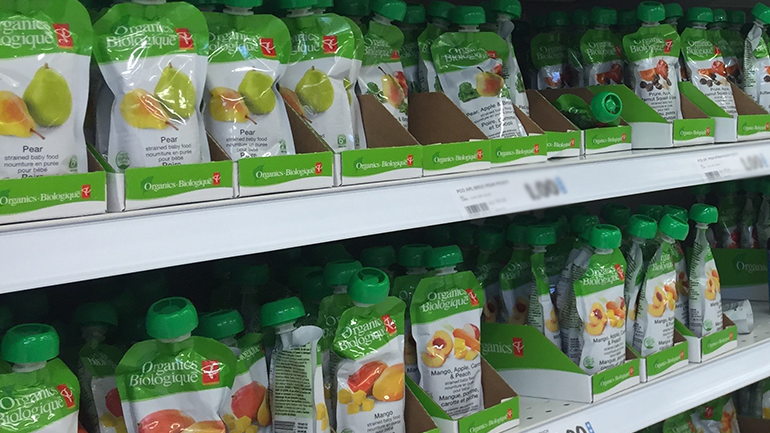
Walking down the baby food aisle, parents are surrounded by shelves of colourful food pouches, offering vegetables, fruits and grains in a single-serve packet. Our dietitians weigh in on this popular food fad.
Walking down the baby food aisle, parents are surrounded by shelves of colourful food pouches labelled "organic," "real fruits and vegetables" and "no preservatives." The flavour combinations are limitless, boasting combos such as "peach, pumpkin and amaranth." The convenience of vegetables, fruits and in some cases grains in a single-serve packet is not lost on today’s busy parent, who admit it can be an easy way to get veggies into a picky toddler.
In a pinch, these baby food pouches can be given for an occasional snack on-the-go but as with many other packaged foods, they aren’t recommended for regular consumption or to replace meals and snacks of whole foods.
Here's why:
- Eating is an exploratory experience. Children learn how to eat by seeing, touching and smelling their food. Picking up and playing with food helps children develop fine motor skills. Allow your child to experience what a real peach tastes, looks, smells and feels like – rather than sucking out a single-textured, multiple-flavoured purée.
- Early exposure to differing food textures increases acceptance. At around six months of age when babies are introduced to solid foods, it’s important to offer a range of textures early on so they can develop the necessary eating skills and be less resistant to food textures later on. Children who lack experience with textures often reject nutritious foods that require coordination and endurance to chew.
- They lack nutritional punch. Baby food pouches tend to be higher in sugar and lower in fibre compared to the real fruit or vegetable.
- Regular family food at mealtimes is better. It’s best for children to eat what the rest of the family eats during mealtimes and save yourself the time and energy from preparing a separate meal. This supports development of healthy eating habits and encourages your toddler to explore new foods. The texture can be easily changed as needed with a knife and fork.
- Chewing is necessary for healthy teeth and jaw development. Eating solid foods with more texture teaches the tongue to transition to a mature chew-swallowing pattern which helps the teeth, jaw and skull to grow correctly. Chewing also stimulates the release of enzymes and lubricants in the mouth important to the process of digestion. The lack of these oral experiences can also result in hyperactive gag reflexes which can really slow down a child’s acceptance of new foods and textures.
- They pose a greater risk of tooth decay. Sucking on food pouches for long periods of time allows bacteria to build in the mouth which can weaken tooth enamel. Pureed foods tend to sit on the teeth and this can lead to tooth decay. Chewing, on the other hand, promotes the production of saliva which helps wash food and bacteria off the teeth.
Building long-term health eating habits
For kids, trying out new textures, playing with, and exploring new foods are central in developing healthy eating habits well into their adulthood. These habits include:
- Enjoying and feeling good about eating
- Trying new foods
- Listening to hunger cues
- Enjoying being at the table with the family
Tip: Homemade snacks are generally the best option. Stick to fresh fruits and vegetables either mashed or cut to small pieces. Serve them with a variety of dips like hummus or yogurt to make the eating experience more interesting and to add additional nutrition to a snack.
If you do opt for the baby food pouch, try to offer it in a bowl with a spoon. It is better for the child to see the food and take as much or as little as he or she wants.
